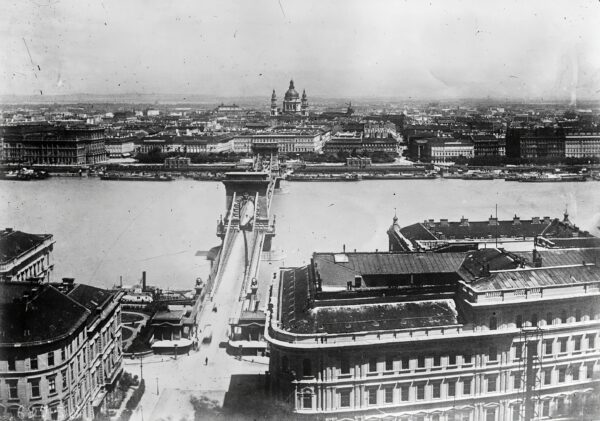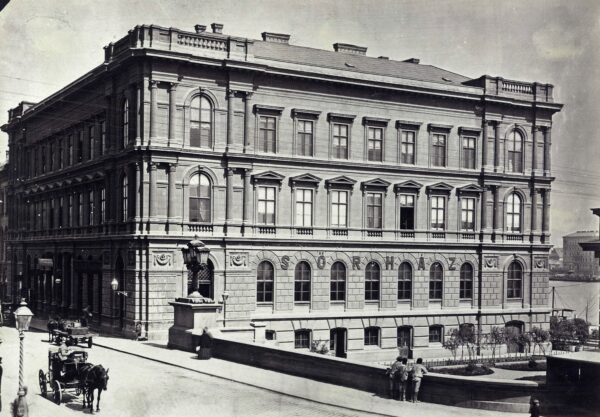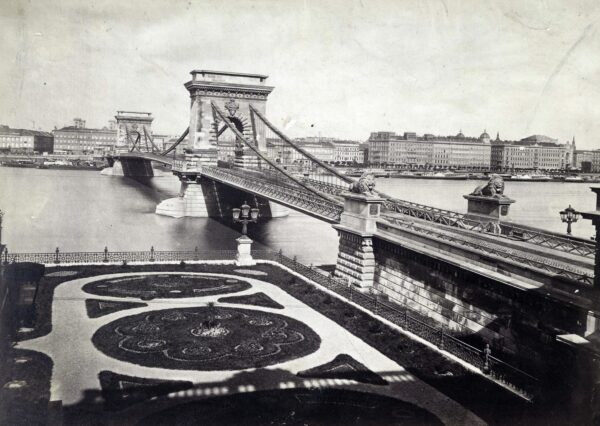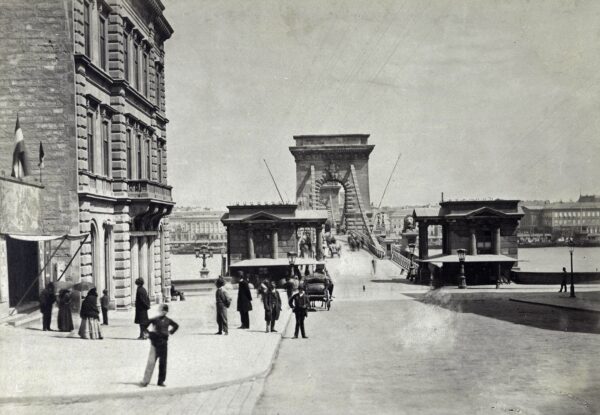Budapest chain bridge ltd

Although you might think that running the Chain Bridge was a good business at the time, as it was the only bridge connecting Pest and Buda, it was not. The Chain Bridge Joint Stock Company, founded in 1838 by George Sina, not only operated the bridge, but also built it. The construction also resulted in considerable over-expenditure, so the company had to roll over a relatively large loan, which varied from year to year, but averaged 1-1.2 million forints. Originally, 10 000 shares with a nominal value of HUF 500 each were issued, which could be bought in instalments, but this HUF 5 000 000 (in fact nominal) capital was not even enough to build the bridge, hence the large debt. After several attempts to settle the debt, a lottery bond was finally issued in 1866 for HUF 1.4 million to complete the construction.
The Lánchíd was built between 1839 and 1849 by the company on the basis of the 1836 Act XXVI of 1836. The company charged a toll for passage, not in fact a user charge, but a kind of toll collected on each crossing made in the course of a business, according to the rates set by the contract concluded with the State in 1838, so that the toll paid to the Chain Bridge Company was included in the price of the boats crossing.
The main task of the company was to build and operate the bridge, but it also had many other tasks and costs. On the one hand, it was liable to pay compensation to the original owners of the toll, the two towns, but the amount was not specified in the law or the contract and was only agreed after lengthy litigation. The final contract with the Chain Railway Company was signed by Buda on 30 September 1863 and by Pest on 15 February 1864. Under this agreement, the two cities received compensation of 200-200 000 forints, but until the expiry of the patent period, the company only had to pay the annual interest of 6%, i.e. 12-12 000 forints.

According to the contract, the company was supposed to deposit a fund of HUF 100 000, the amount of which, plus interest, would have been used to cover the possible repair of the bridge when it would be transferred to the state after 87 years, as stipulated in the contract. However, the company was never able to deposit this sum.
The profitability of the bridge was greatly affected by the fact that the contract with the state did not regulate the crossing of the military, and the disputes with the Viennese government were only settled in the spring of 1860, after which the state paid a flat rate.
The business was loss-making until 1861, and only made a profit from 1861 onwards, one reason being the significant increase in traffic with the opening of the Southern Railway's Buda station. This affected the guaranteed interest rate on the shares and the share price, as the shares bore interest at 5 % from 1 June 1841 to 31 October 1849, then only 4 %, and the shares did not reach par value until the second half of the 1860s. It is true that the majority of the shares were held by the Sina and Wodianer banking houses, with George Sina holding 2,712 shares, 27% of the total 10,000 shares at his death in 1856.
The company was responsible for the ongoing maintenance of the bridge, and as the original structure of the Chain Bridge was partly made of wood, this meant ongoing expenditure, as it had to be painted from time to time. Other maintenance work had to be carried out, but in 1859, for example, gas lighting was introduced on the bridge.

One of the aims of the responsible Hungarian government that came to power in 1867 was to develop Budapest into a capital city on a par with Vienna. To this end, it announced a major urban development policy, in which central government involvement was planned. However, one of the main obstacles to one of the key issues of urban development, the building of further bridges, was the privilege of the Chain Railway Company, which was granted the right in 1838 not only to collect tolls for crossing the Danube, but also to prevent the construction of other crossings within the boundaries of cities (but only within those boundaries) without its permission.
For this reason, and because of the considerable revenue from the bridge tolls by the end of the 1860s - which would have covered a large part of the repayment of the loan taken out for the city's development - the government started negotiations with the Chain Bridge Company about taking over the bridge (there had been earlier attempts to buy it from the state, in 1851 and 1856).The biggest issue was the price, of course, and the final price agreed was 690 forints per share. On this basis, the state bought the 9,816 shares still in circulation for HUF 6,773,040, and the Chain Bridge joint-stock company ceased to exist. The contract was ratified by Act XXX of 1870.

Interesting facts
"Long before the Compromise, Count Gyula Andrássy once approached Lónyay and said to him, "You are a skilled finisher, I have come to ask your advice. I have some money lying around. Tell me, what shall I do with it?
- "I can give you no better advice," said Lónyay, "than what I myself am following: buy a chain of shares in the money.
- "Lánchid share," cried Andrassy, "but that is very bad paper.
"Now it is bad," said Lónyay, "but if there is a reconciliation, if the country gains its constitutional rights, then the privilege of the Chain Bridge must be lifted and the Danube must be made free. And this is only possible if the country takes the bridge for its own. And if this happens, the Chain Bridge share will immediately become a piece of paper." - the legend was quoted in the Budapest Herald of 2 December 1906 in an article entitled "Count Gyula Andrássy"
Sources:
- Csaba Domonkos:The History of the Chain Bridge from 1849 to the 21st Century, 2024, Budapest, Hungarian Museum of Technology and Transport.
- Minutes of the General Assembly of the Chain Railway Company
Date of foundation: 1838
Date of cessation: 1870
Founders: György Sina, Móric Wodiáner, István Count Széchenyi
Securities issued:
| Budapest Chain Bridge Preference Bond |
| Budapest Chain Bridge Shares |
Decisive leaders:
György Károlyi | |
until 1856 | George Sina |
1856-1870 | Sina Simon |
Main activity: bridge construction, bridge maintenance
Author: by Domonkos Csaba
Date of foundation: 1838
Founders: György Sina, Móric Wodiáner, István Count Széchenyi
Decisive leaders:
György Károlyi | |
until 1856 | George Sina |
1856-1870 | Sina Simon |
Main activity: bridge construction, bridge maintenance
Main products are not set
Seats are not configured
Locations are not set
Main milestones are not set
Author: by Domonkos Csaba
Budapest chain bridge ltd

Although you might think that running the Chain Bridge was a good business at the time, as it was the only bridge connecting Pest and Buda, it was not. The Chain Bridge Joint Stock Company, founded in 1838 by George Sina, not only operated the bridge, but also built it. The construction also resulted in considerable over-expenditure, so the company had to roll over a relatively large loan, which varied from year to year, but averaged 1-1.2 million forints. Originally, 10 000 shares with a nominal value of HUF 500 each were issued, which could be bought in instalments, but this HUF 5 000 000 (in fact nominal) capital was not even enough to build the bridge, hence the large debt. After several attempts to settle the debt, a lottery bond was finally issued in 1866 for HUF 1.4 million to complete the construction.
The Lánchíd was built between 1839 and 1849 by the company on the basis of the 1836 Act XXVI of 1836. The company charged a toll for passage, not in fact a user charge, but a kind of toll collected on each crossing made in the course of a business, according to the rates set by the contract concluded with the State in 1838, so that the toll paid to the Chain Bridge Company was included in the price of the boats crossing.
The main task of the company was to build and operate the bridge, but it also had many other tasks and costs. On the one hand, it was liable to pay compensation to the original owners of the toll, the two towns, but the amount was not specified in the law or the contract and was only agreed after lengthy litigation. The final contract with the Chain Railway Company was signed by Buda on 30 September 1863 and by Pest on 15 February 1864. Under this agreement, the two cities received compensation of 200-200 000 forints, but until the expiry of the patent period, the company only had to pay the annual interest of 6%, i.e. 12-12 000 forints.

According to the contract, the company was supposed to deposit a fund of HUF 100 000, the amount of which, plus interest, would have been used to cover the possible repair of the bridge when it would be transferred to the state after 87 years, as stipulated in the contract. However, the company was never able to deposit this sum.
The profitability of the bridge was greatly affected by the fact that the contract with the state did not regulate the crossing of the military, and the disputes with the Viennese government were only settled in the spring of 1860, after which the state paid a flat rate.
The business was loss-making until 1861, and only made a profit from 1861 onwards, one reason being the significant increase in traffic with the opening of the Southern Railway's Buda station. This affected the guaranteed interest rate on the shares and the share price, as the shares bore interest at 5 % from 1 June 1841 to 31 October 1849, then only 4 %, and the shares did not reach par value until the second half of the 1860s. It is true that the majority of the shares were held by the Sina and Wodianer banking houses, with George Sina holding 2,712 shares, 27% of the total 10,000 shares at his death in 1856.
The company was responsible for the ongoing maintenance of the bridge, and as the original structure of the Chain Bridge was partly made of wood, this meant ongoing expenditure, as it had to be painted from time to time. Other maintenance work had to be carried out, but in 1859, for example, gas lighting was introduced on the bridge.

One of the aims of the responsible Hungarian government that came to power in 1867 was to develop Budapest into a capital city on a par with Vienna. To this end, it announced a major urban development policy, in which central government involvement was planned. However, one of the main obstacles to one of the key issues of urban development, the building of further bridges, was the privilege of the Chain Railway Company, which was granted the right in 1838 not only to collect tolls for crossing the Danube, but also to prevent the construction of other crossings within the boundaries of cities (but only within those boundaries) without its permission.
For this reason, and because of the considerable revenue from the bridge tolls by the end of the 1860s - which would have covered a large part of the repayment of the loan taken out for the city's development - the government started negotiations with the Chain Bridge Company about taking over the bridge (there had been earlier attempts to buy it from the state, in 1851 and 1856).The biggest issue was the price, of course, and the final price agreed was 690 forints per share. On this basis, the state bought the 9,816 shares still in circulation for HUF 6,773,040, and the Chain Bridge joint-stock company ceased to exist. The contract was ratified by Act XXX of 1870.

Interesting facts
"Long before the Compromise, Count Gyula Andrássy once approached Lónyay and said to him, "You are a skilled finisher, I have come to ask your advice. I have some money lying around. Tell me, what shall I do with it?
- "I can give you no better advice," said Lónyay, "than what I myself am following: buy a chain of shares in the money.
- "Lánchid share," cried Andrassy, "but that is very bad paper.
"Now it is bad," said Lónyay, "but if there is a reconciliation, if the country gains its constitutional rights, then the privilege of the Chain Bridge must be lifted and the Danube must be made free. And this is only possible if the country takes the bridge for its own. And if this happens, the Chain Bridge share will immediately become a piece of paper." - the legend was quoted in the Budapest Herald of 2 December 1906 in an article entitled "Count Gyula Andrássy"
Sources:
- Csaba Domonkos:The History of the Chain Bridge from 1849 to the 21st Century, 2024, Budapest, Hungarian Museum of Technology and Transport.
- Minutes of the General Assembly of the Chain Railway Company